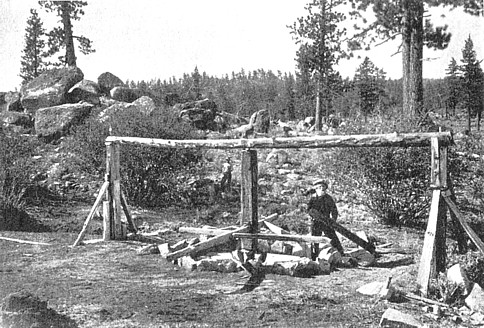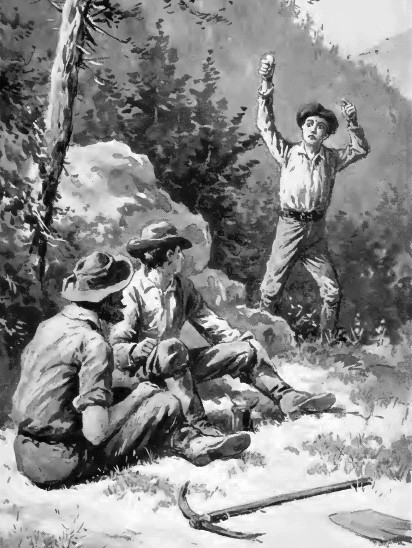In 1861, according to Lieut. Sylvester Mowry, American miners had spread themselves very generally over the southern part of Arizona, usually working old Spanish mines with Mexican labor. Of large importance was the Patagonia or Mowry mine, an "antigua" still operated. It was then described as being ten miles from the boundary line, twenty miles from Fort Buchanan and fourteen miles from the town of Santa Cruz in Sonora. Freight from San Francisco, by way of Guaymas, was at a cost of 4 to 5 cents a pound. At that date the mine had been worked for about three years for rich surface silver ore. It was located by Col. J. W. Douglass and a Mr. Doss and by Capt. R. S. Ewell and Lieutenants Moore, Randal and Lord of the United States Army. After continued disagreements among the partners, and expenditure of $200,000, four fifths of the property was conveyed to S. Mowry, who operated the mine, after his retirement from the army, till arrested by order of General Carleton and confined at Yuma, a military post he had once commanded. It is doubtful if he found much profit, for the ores of his property to-day are considered notably refractory.
Among the men who were identified with early American mining in the Santa Cruz Valley were a number who enjoyed the largest prominence then or later. Besides Poston and Mowry and Ehreuberg were included Gen. S. P. Heintzelman, Col. C. P. Stone, later called by the Khedive to the organization of the Egyptian army, Prof. Raphael Pumpelly, S. F. Butterworth, Col. John D. Graham and Frederick Brunckow. There was heavy toll of life taken by the Apaches and Mexicans and among the victims of the latter was a brother of Colonel Poston. Though there were wonderful stories of wonderful finds, and the assays seemed usually to get up into the thousands of dollars, the actual returns from mining in the days before the Civil War appear to have been far from phenomenal. For instance, one of the richest of the silver mines is assumed to have been the Heintzelman, thirty miles from Tubac. Though some of the ore sampled up to $1,000 a ton, the gross value of the ores hoisted in 1860 ran only $70,804. The first run of bullion from Heintzelman and Arivaca ores, made in 1858, was from a small mud furnace that cost $250.
It took 600 hours to smelt about 22,800 pounds of ore, from which were secured 2,287 ounces of silver and 300 pounds of copper, no mention being made of the lead. Later the Freiberg system of barrel amalgamation was used, under the direction of Pumpelly and of the German experts, Ehrenberg, Brunckow and Kustel. The Heintzelman mine was the principal mine of the Sonora Exploring and Mining Company, of which Gen. S. P. Heintzelman was President. The corporation, mainly capitalized in Connecticut, had far from a prosperous career. In a report made by the President, Samuel Colt, on May 1, 1859, after a quarter of a million dollars had been sunk, he stated his belief in the mine, but added, "In the hands of a half-horse concern, pulling all ways and dragging its slow length along, it is but a hole to bury money in." The company was organized in Cincinnati in March, 1856, for the purpose of exploring the old silver mining country of northern Sonora. With Poston at its head, an expedition was fitted out at San Antonio, Texas, arriving at Tucson August 22, 1856, soon thereafter occupying the old to-mi of Tubac.
Poston, an enthusiast and dreamer, sent Thereafter for about six months his name occasionally appears in connection with the location, as witness or locator, of the Emmett, Halcro, Virginia, Excelsior, Iron Springs, Dixie, Wade Hampton and Tar Heel claims. One of the owners of the Robb was D. B. Rea, a Tucson lawyer, who brought into Bisbee in April, 1878, one Warner Buck, who knew something about assaying and smelting and who built a little smelter, with a large bellows to furnish the blast. The Hendricks mine was located in April, 1878, by Rea. Twelve mining claims were located in the vicinity of Bisbee in 1877. In 1878 fourteen claims were filed and two relocations, but in 1879 only three locations were recorded of claims in Mule Gulch.
The Copper Queen mine, the original Mercey, was located on December 15, 1879, by George H. Eddleman and M. A. Herring. Eddleman ten days before had located the Mammoth on the old Robb ground. Warren sold or lost most of his mining property within a few years. It is told that he lost his interest in one claim by a drunken wager that on foot he could make a short distance up the gulch faster than another man could on horseback. In 1881 he was brought before the probate judge of Cochise County on a charge of insanity and George Pridgen was appointed his guardian. His estate was found to be a twelfth interest in the Mammoth mine, a third interest in the Safford and a third interest in the Crescent, in all valued at and by the guardian sold for $925. Despite his detention for a while in the county jail as a person dangerous to be at large, it would appear that his dementia must have been of very mild character, probably due to intoxicants, for he was released before long, but penniless. Then it is told that he went to Mexico, where he practically subjected himself to peonage. His Mexican debt was paid by Judge G. H. Berry. Warren after thus regaining his liberty returned to Bisbee, where he lived for several years precariously, given a small pension by the Copper Queen Company and doing odd jobs, such as sawing wood, till he died a few years later.
Early in 1914 the Bisbee Lodge of Elks set on foot an investigation and found the grave of George Warren in the poorer part of the Bisbee Cemetery, identified by a small rotted wooden headboard, simply marked "G. W." The body was transferred to a more prominent location and there was provided a monument more in keeping with the distinction of the man whose last resting place thus was marked. Judge Jas. F. Duncan made a visit to Bisbee in the late fall of 1879 from his camp a short distance from Tombstone. The trip was made around by San Pedro Valley, and hardly a trail could be found into the lower end of Mule Pass, which was entered November 7. He records in his notations what appeared to be the entire population of the village, Marcus A. Herring, better known as "Kentuck," George Eddleman, D. B. Rea, George Warren, Chas. Vincent and Joe Dyer. The camp even then had some history for relation. There was seen the little Rea furnace from which some matte had been shipped, but which had failed to pay expenses. There had been two deaths, Paddy Dyer and Joe Herring, the latter a brother of Col. William Herring, later a distinguished Arizona attorney, but no relation to "Kentuck."
Return
to The Arizona Page:
Arizona Gold Rush Mining History



